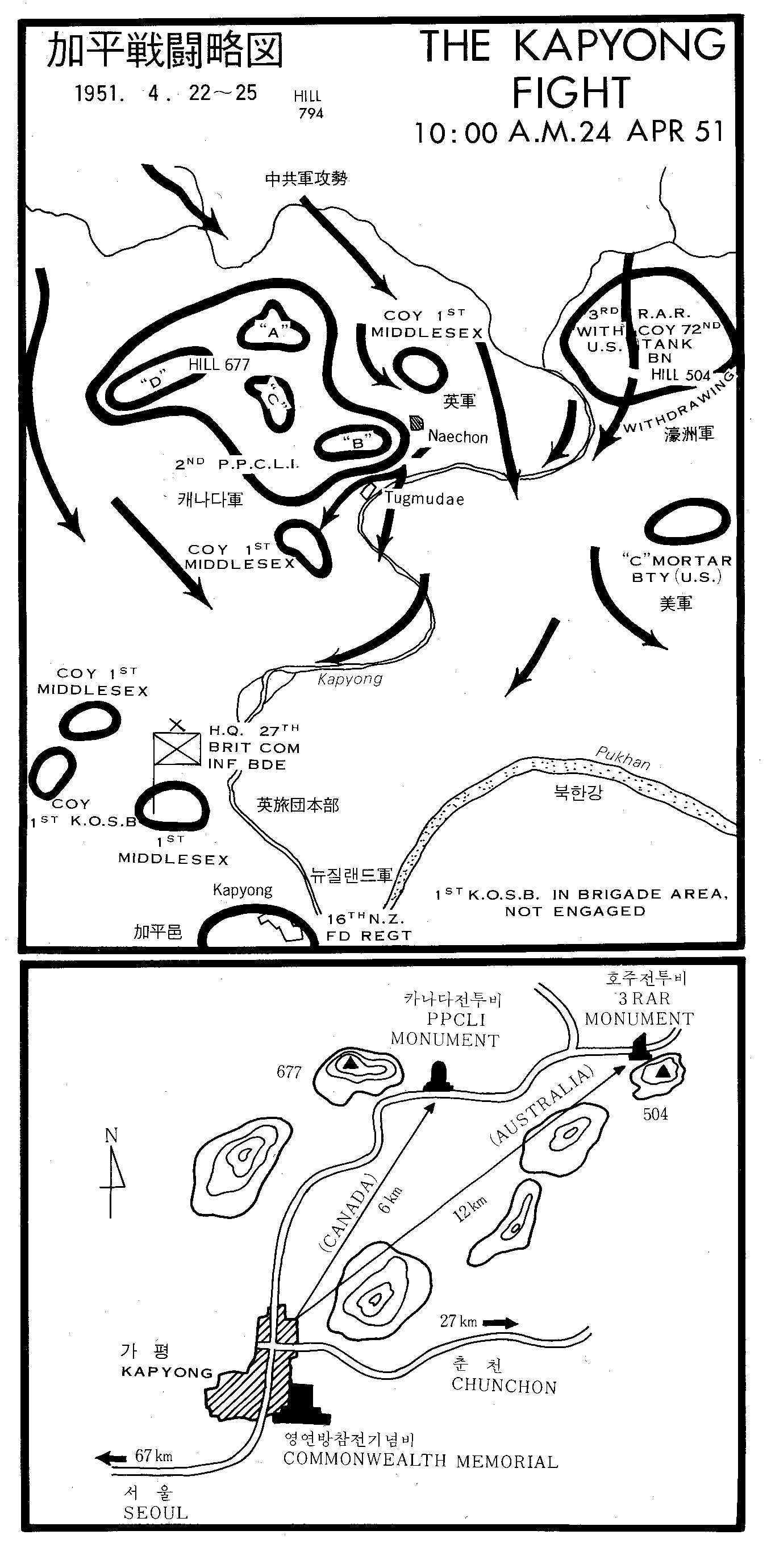THE
BATTLE OF KAPYONG
Throughout
the winter of 1950 27 Brigade had been involved in fighting as par north as the
Yalu river. By the early spring, it had been placed in Corps reserve not
far south of Kapyong, for much needed rest and retraining.
On
the evening of 22 April 1951 the Chinese spring offensive began. The attack was
mounted across a broad front and set against enormous odds the allied positions
began to crumble.
The
1st Battalion the Middlesex Regiment and 16 Field Regiment Royal New Zealand
Artillery (of the Brigade) were virtually cut off.
To relieve these two units the remainder of the Brigade was ordered into
a blocking position just north of Kapyong.
The forward positions were held by 2nd Battalion The Princess Patricia's
Canadian Light Infantry and the 3rd Battalion the Royal Australian Regiment; 1st
Battalion the Middlesex Regiment was withdrawn and placed in reserve.
Meanwhile the 16 Field Regiment Royal New Zealand Artillery had also
redeployed and together with 72 Heavy Tank Battalion United States Army provided
27 Brigade with its close support.
The
Brigade's mission was to deny to the enemy the two approaches to Kapyong.
It had only hours in which to prepare positions before the continuing
Chinese onslaught, now led by the 118th Chinese Peoples Volunteer Division, made
contact with the two forward battalions on the evening of 23 April.
The
initial Chinese thrust came against the Australian position, where it net dogged
resistance; the attack switched to the
Canadian front. A fierce contact
battle ensued along the whole Brigade front in which the now familiar waves of
massed and screaming Chinese, armed with grenades and light machine guns were
repulsed by defiant and determined Commonwealth troops.
Throughout the night of 23 April repeated attacks were made and repelled;
nevertheless, by morning at great cost the Chinese had infiltrated the Brigade
position. For 24 hours Princess
Patricia's Canadian Light Infantry were completely surrounded.
During this critical period they were resupplied by air.
The
battle raged throughout the 24 April. Ground
was tenaciously held and rarely given. The battle developed into one of personal
contact in which bayonet charges were a feature; there resulted some of the
bloodiest and most ferocious hand to hand fighting of the Korean War.
By the evening of 24 April, in spite of conceding some ground it became
obvious that the Chinese attack had been blunted; the 27th Commonwealth Brigade
in its sector had halted the advance on Seoul.
The Australian withdrawal during the Battle of Kapyong is till cited as a
military model of a fighting withdrawal.
In
this action 10 Canadians were killed and 23 wounded; 31 Australians were killed,
with 59 wounded and 3 captured, 2 New Zealanders were killed and 5 wounded - but
the Commonwealth Brigade had successfully halted the Chinese advance.
They had won a bloody encounter and earned themselves the professional
admiration of their allies.
In
recognition for their part in the Battle of Kapyong, the 2nd Princess Patricia's
Canadian Light Infantry, the 3rd Royal Australian Regiment, and 'A' Company of
the 72 Heavy Tank Battalion United States Army, received the United States
Presidential Citation.
The
following maps depict the positions that 27th Commonwealth Brigade held
during the battle.

